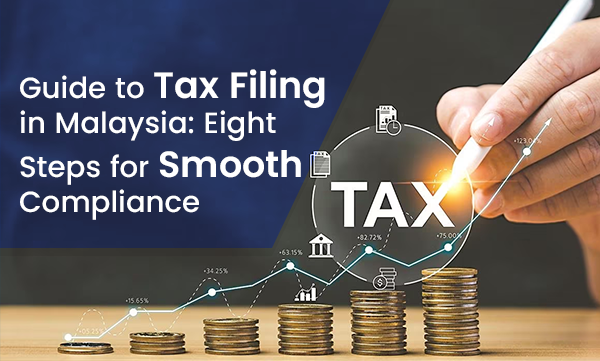
Guide to Tax Filing in Malaysia: Eight Steps for Smooth Compliance
Introduction
Welcome to our comprehensive guide: "Guide to Tax Filing in Malaysia: Eight Steps for Smooth Compliance." Tax filing can be a daunting task, but with the right guidance, you can navigate the process smoothly and ensure compliance with Malaysian tax laws. In this blog post, we'll walk you through eight essential steps to simplify your tax filing journey. Whether you're a seasoned taxpayer or filing for the first time, this guide will provide you with the knowledge and tools you need to navigate the intricacies of tax filing in Malaysia with confidence. Let's dive in and demystify the tax filing process together.
Step 1: Obtain the Necessary Documentation
The first crucial step in the tax filing process is to gather all the required documentation. This includes your EA Form, which provides a summary of your remuneration from your employer. Additionally, you'll need Form BE for individuals, along with any supporting documents such as receipts for tax-deductible expenses. Having these documents in hand sets the groundwork for a smooth and efficient tax filing experience.
Step 2: Determine Your Tax Resident Status
Understanding your tax residency status is essential as it determines the tax rates applicable to you. If you've spent more than 182 days in Malaysia during the tax year, you're classified as a resident. Conversely, if your stay is less than 182 days, you're considered a non-resident. These distinctions have implications on the tax slabs that apply to you, so it's crucial to determine your status accurately.
Step 3: Complete the Form B or BE
Once you've determined your tax residency status, you'll need to complete either Form B or BE, depending on your income sources. Form B is for individuals with business income, while Form BE is for those with employment income. Ensure that you provide accurate information regarding your income, deductions, and tax reliefs to avoid discrepancies during assessment.
Step 4: Calculate Your Taxable Income
Calculating your taxable income involves subtracting allowable deductions and tax reliefs from your total income. Be mindful of non-taxable gifts and individual tax reliefs applicable for the tax year. Refer to guidelines provided by LHDN to ensure accuracy in your calculations. It's essential to understand the various deductions and reliefs available to optimize your tax liabilities
Step 5: Submit Your Tax Return
Once you've completed the necessary forms and calculations, it's time to submit your tax return to LHDN. Utilize the e-Filing system for electronic submission, which streamlines the process and reduces the likelihood of errors. Ensure that you attach any supporting documents required for your tax return to facilitate the assessment process.
Step 6: Pay any Outstanding Taxes
If you have outstanding taxes after deductions and reliefs, make the necessary payment to LHDN by the specified deadline. Failure to do so may result in penalties and fines, so it's essential to settle your tax liabilities promptly. Take note of the payment methods accepted by LHDN and ensure that you adhere to the deadlines to avoid any penalties.
Step 7: Await Assessment and Refund (if applicable)
After submitting your tax return, await assessment by LHDN. If you've overpaid taxes or are eligible for a refund, LHDN will issue the refund accordingly. Be patient during this process as assessment timelines may vary depending on various factors. Keep track of any notifications from LHDN regarding your tax assessment and refund status.
Step 8: Keep Records for Future Reference
Lastly, maintain copies of your tax return, supporting documents, and any correspondence with LHDN for future reference. These records are crucial for audit purposes and may be required for future tax filings. Organize your documents systematically to ensure easy retrieval when needed and keep them in a secure location to protect sensitive information.
By following these eight steps diligently, you can navigate the tax filing process in Malaysia smoothly and ensure compliance with tax laws. Stay informed, keep accurate records, and seek professional advice when needed to optimize your tax planning and filing strategies. With proper preparation and understanding, tax filing can be a manageable task, allowing you to focus on your financial goals with confidence.
Conclusion
In conclusion, navigating the tax filing process in Malaysia doesn't have to be daunting. By following the eight essential steps outlined in this guide, you can streamline your tax filing experience and ensure compliance with Malaysian tax laws. From obtaining the necessary documentation to submitting your tax return and awaiting assessment, each step plays a crucial role in achieving smooth compliance.
It's essential to stay informed about changes in tax regulations, utilize online resources provided by LHDN, and seek professional advice when needed. By taking a proactive approach to tax planning and filing, you can minimize stress and optimize your tax liabilities.
Remember to keep accurate records of your tax filings, supporting documents, and correspondence with LHDN for future reference. These records are valuable assets that can help you navigate future tax filings and potential audits with ease.
Ultimately, by following this comprehensive guide and understanding the nuances of the tax filing process, you can approach tax season with confidence and peace of mind. With proper preparation and diligence, you can fulfill your tax obligations efficiently and focus on achieving your financial goals.
If you are still unsure on the topic and require some extra help, do not hesitate to contact our HR Consultants who can guide you on your tax filing journey from start to finish.


